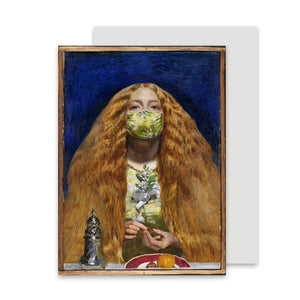
Like a newly caged bird, she moves restlessly in her leafy nook.
Keshav Das, Rasikpriya, written circa 1590
This image of a beautiful young woman waiting on the bank of a river is inspired by Indian love poetry. The sixteenth-century Indian court poet Keshav Das categorised eight different types of nayika – female lovers. The girl we see depicted here (in this eighteenth century masterpiece) is an utka nayika – a girl awaiting her lover in a garden, nervous and impatient.
There is something lyrical about the painting's very construction, with its visual rhymes and echoes. The girl's graceful posture, which looks like a movement from a dance, is picked up by shapes within the tree – see the details left and right. A branch continues the elegant curve of her right arm. A creeper twists itself around the trunk as her right leg wraps itself over her left. The flowers embroidered on her gossamer-thin, muslin garment are echoed by the foliage. It is almost as if she is trying to blend into the tree, as though she is hiding and has suddenly been exposed by the flash of lightning.
The lightning itself, left, is echoed by the hem of the girl's garment. She is immaculately dressed and made up: her ears are studded with precious stones, and jewels adorn her forehead. A gold necklace encircles her pale throat and there are bracelets around her ankle, wrists and arm. A flower-like brooch nestles between her breasts. Her hands and feet are henna-ed.
All this studied elegance contrasts sharply with the wild nature around her. It is a surprise to see so glamorous and well-groomed a figure outside on so tempestuous a night. Is her hand raised to her head in a gesture of alarm? She looks up and behind her shoulder at the lightning as though it has suddenly caught her attention. Her pale skin against the black background makes her seem vulnerable, exposed.
There is a sense of nervous apprehension here. Although the bed of leaves suggest that she is expecting loving company, she is at the moment alone. Will he come? The jagged flash of lightning perhaps reflects the uncertainty and the excitement of her emotions.
It also, doubtless, hints at the passion to come. Another sixteenth-century Indian poem imagines a girl in a position very like ours here, speaking to her lover.
Take me to a country I have never seen,
Where, O my love, the thunder roars,
Where, O my love, the lightning flickers,
And the rain pours down.
The violence of the storm anticipates the – as yet undiscovered – pleasures of the flesh.
Themes and periods
Data from our collections database
Legal notes
Bequeathed by P.C. Manuk and Miss G.M. Coles in 1946 through the National Art Collections Fund.
Acquisition and important dates
- Method of acquisition: Bequeathed
- Dates: 1948
Dating
- Production date: circa AD 1790
Maker(s)
- Unknown Miniaturist









